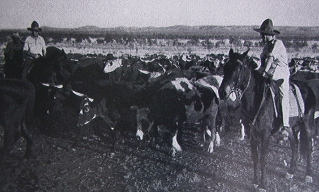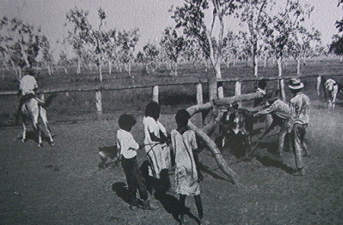THEME: ‘Cattle Ranching’
SUBJECT AREAS: History
TOPIC: development of Victoria River cattle stations
“There can be no doubt from authentic reports which have reached me that the Victoria River country contains some of the finest pastoral lands in Australia.” (Government Resident, 1884)
Thanks to the glowing reports written by AC Gregory after his 1850s expedition to explore the Victoria River district, pastoral activity and European settlement of the Northern Territory began in earnest.
The 1880s saw the development of the large cattle stations which are still in use today, i.e. Victoria River Downs, 1884, Wave Hill, 1883. Moolooloo station, which we recently visited, is a part of the Victoria River Downs land holdings.

Nat ‘Bluey’ Buchanan, a great cattleman and drover, was responsible for stocking these early stations with thousands of head of cattle. He led many drives through Queensland into the Northern Territory, including what was the largest cattle drive ever undertaken in Australia: the movement of 20,000 head from Aramac in Queensland to Glenco Station near Adelaide River in the Northern Territory. Buchanan’s herds numbered in the thousands and were often plagued by the country’s roughness in crossing, occasional droughts, and mile after mile of moving cattle from one grassland to another. Many cattle were lost to tick fever and accompanying diseases, but he still managed to arrive with enough cattle to stock the cattle stations. These large land holdings were well established by 1915 and saw little change for the next fifty years.
The cattle stations were originally stocked with traditional English breeds, Hereford, Angus, and Shorthorn. These cattle suffered in the semi-tropical climate as their hair coat was too thick and they were not resistant to ticks, which are abundant in this region. Today, the English breeds have been replaced with the Brahma cattle, originally from India. Their shorter hair coat, plus natural resistance to disease makes them more adaptable to this climate.

The cattle industry became the backbone of the Territory economy and in the post WWII recovery period of the 1950s came a global demand for beef, particularly from Britain. This demand led to today’s infrastructure across the Northern Territory in relation to roads built to transport large numbers of cattle.
During the dry season, cattle were mustered, branded by use of a bronco panel, then sorted for distant markets or to restock the station. Stores were hauled in and work to build and repair the cattle yards was completed. During the wet season, most station workers were laid off. General maintenance to the station itself was completed at this time as roads and paddocks became inundated with water and were often impassable. Station life has changed little since the early days of the cattle industry in the Northern Territory.
Suggested activities: Investigate the livestock industry in your area. When was it established? Discuss how farming or ranching impacts the local economy. What livestock is raised in your area? Why is your local area suited for this type of agriculture?
April